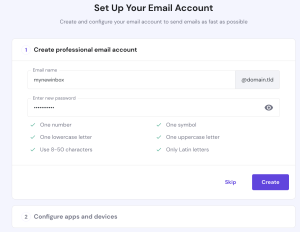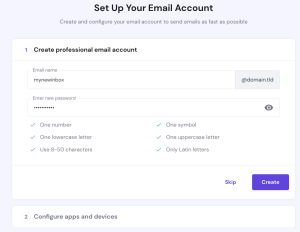[ad_1]
In today’s fast-paced business world, email communication plays a vital role in ensuring smooth and efficient operations. While there are many email service providers available, Gmail stands out as a popular choice for businesses due to its user-friendly interface, robust features, and customization options. One such feature that can streamline your business email is Gmail’s custom domain feature. In this article, we will explore how this feature can benefit your business and the steps to set it up.
Firstly, let’s understand what a custom domain is and why it is essential for your business email. A custom domain allows you to use your own domain name for your email address instead of relying on a generic email address provided by the email service provider. For instance, instead of having an email address like yourbusiness@gmail.com, you can have an email address like info@yourbusiness.com.
Having a custom domain brings several advantages. Firstly, it gives your business a more professional image. Using a generic email domain can sometimes create a perception that your business is small or not trustworthy. With a custom domain, you can showcase your brand identity and make a positive impression on clients and business partners.
Additionally, a custom domain helps with brand consistency. Your email address will match your website URL, creating a cohesive and unified brand presence. This consistency enhances your brand recognition and reinforces your credibility in the eyes of your stakeholders.
Furthermore, a custom domain allows you to have more control over your email infrastructure. You can easily manage and organize your email accounts, create custom aliases, and set up email forwarding rules. With Gmail’s custom domain feature, you can also benefit from the advanced spam filtering, virus protection, and reliable infrastructure that Gmail provides.
Now that you understand the importance of a custom domain for your business email, let’s dive into the steps to set it up with Gmail.
Step 1: Purchase a domain name
To get started, you need to purchase a domain name from a domain registrar. There are various popular domain registrars available, such as GoDaddy, Namecheap, or Google Domains. Choose a domain name that aligns with your business and is easy to remember. Once you’ve purchased the domain, it’s time to move on to the next step.

Step 2: Configure DNS settings
After purchasing the domain, you need to configure the DNS settings to point the domain to Gmail’s servers. This step may vary slightly depending on your domain registrar, but the general process remains the same. You will need to create specific DNS records like MX, TXT, and CNAME to establish the connection. Google provides detailed instructions on how to configure DNS settings for Gmail.
Taking a Closer Look at Gmail’s Domains: The Backbone of an Email Empire
Step 3: Set up Gmail for custom domain
Once the DNS settings are correctly configured, you can proceed to set up Gmail for your custom domain. Go to the Google Workspace website and sign in with your Google account. Follow the guided setup process, entering your custom domain name and other relevant information. During this process, you will also need to verify ownership of the domain.
Step 4: Create email accounts and aliases
After setting up Gmail for your custom domain, you can create email accounts for your team members or set up email aliases. Email aliases are alternate email addresses that can be used to receive emails in the same inbox. For example, you can create aliases like sales@yourbusiness.com or support@yourbusiness.com to streamline communication.
Step 5: Configure email forwarding and filters
To further streamline your business email, you can configure email forwarding and apply filters. Email forwarding allows you to automatically forward emails from one account to another, ensuring all relevant team members receive the necessary information. Additionally, you can create filters to automate email organization, such as categorizing emails, marking them as important, or applying specific labels.
In conclusion, Gmail’s custom domain feature is a powerful tool that can enhance your business email communication. By using a custom domain, you can portray a more professional image, maintain brand consistency, and exercise more control over your email infrastructure. Setting up a custom domain with Gmail is a relatively straightforward process that involves purchasing a domain, configuring DNS settings, and completing the Gmail setup. Take advantage of this feature to streamline your business email and elevate your overall communication efficiency.
[ad_2]




